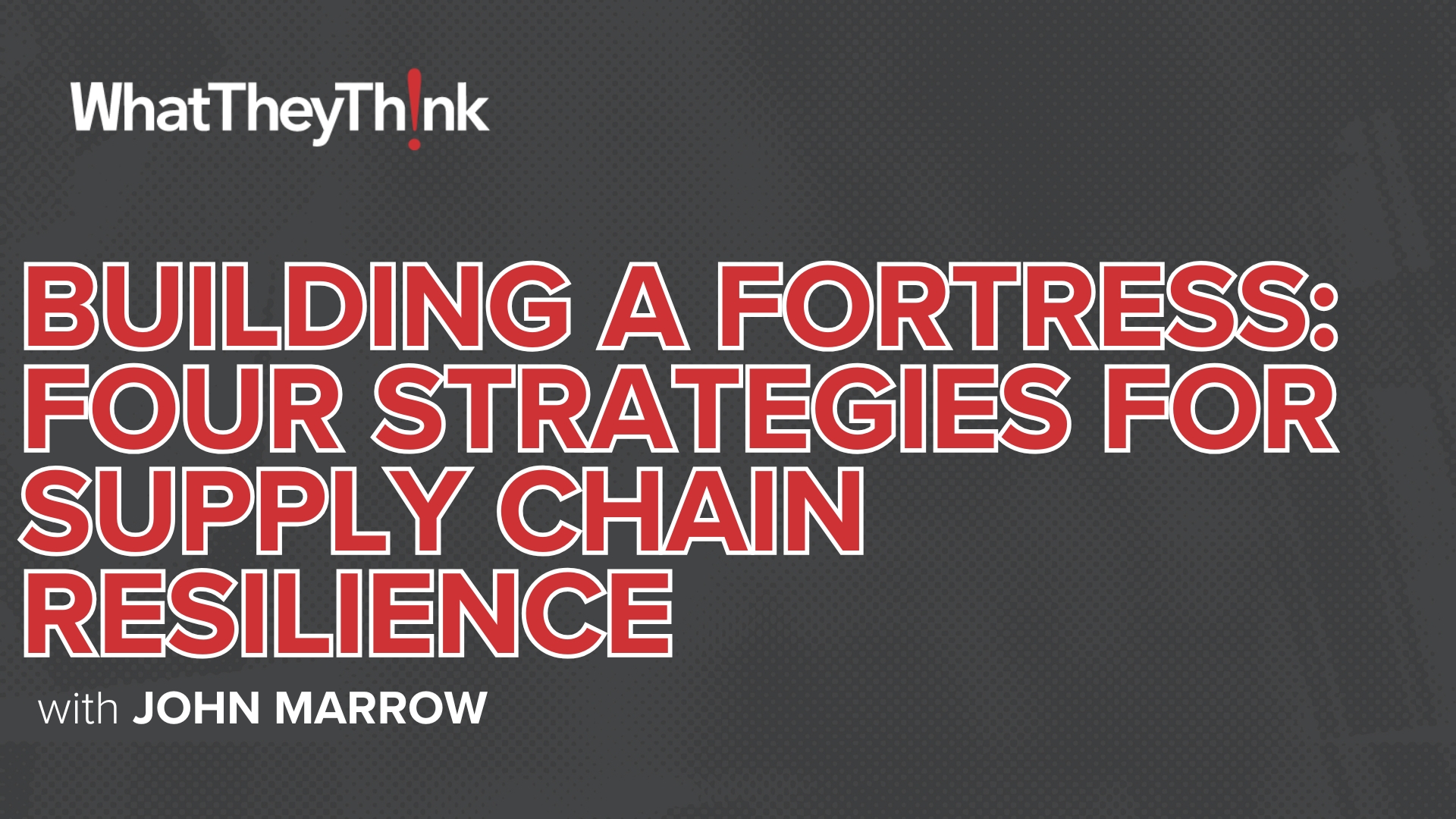Commentary & Analysis
Displaying 1901-2000 of thousands of articles
Insight You Need. Analysis You Trust.
Get the trusted insights you need to understand our evolving industry and emerging trends. Become a Premium Member.
Software Enabled Automation: What? Why? and How?
Software has evolved to allow automation with developers. Print businesses can take advantage of this if they invest in technical leadership and give them a seat at the decision-making table.
Vycom Expands its PVC and Acrylic Recycling Program
Vycom (and its parent, The AZEK Company) launched its Recycling Take Back Program in 2019, accepting hard-to-recycle materials like PVC and other materials used for signage and display graphics and reusing them in decking products, diverting millions of pounds of plastic from landfills. The company has expanded the number of recycling plants, has been adding customers, and is renewing its outreach efforts.
Johnson’s World—If It Is Ink On Paper, It Is Printing: Musings, Droppings, Streams, and Flashes
Digital print or conventional print? Do you have a preference? More importantly, do your clients? If it is ink on paper, it is printing. The rest is just labelling.
Where Brands are Headed with Mass Customization
Mass customization avoids many pitfalls of typical VDP projects because it doesn’t require the development of elaborate cross-sections of personal user data. In this article, sponsored by HP and written by HP Indigo's “Workflow Chef” Gershon Alon, learn how creating such campaigns is relatively worry-free and less complex, yet can be a very effective way of giving each individual the feeling of being unique.
Get Ahead of Your Competitors through Strategic Landmines
WhatTheyThink contributor Lisa Magnuson explains how to be pro-active and re-active toward your competition.
EFI Reggiani Announces New Products at ITMA Asia, Broadening Extensive Digital Textile Printing Line
In its first in-person trade show appearance since the pandemic began, EFI Reggiani displayed its dedication to ongoing innovation for textiles, even during this difficult time. Three new products were announced at ITMA Asia in Shanghai last Friday, as well as ink manufacturing capabilities in Asia and updates to the EFI Reggiani BOLT. Read the full story.
Around the Web: Outage Outrage. Toy Typing. Entomological Eating. Martian Melons. Sonar Strolling. Safe Strolling. HOV Hack. Sponge Songs. Regular Rejoycing.
Who was responsible for Tuesday’s Internet outage? LEGO launches a working model typewriter. Restaurant prevented from locally sourcing cicadas. The NYT reports that watermelons were found on Mars. Anyone can learn echolocation. An inventor creates a third eye for mobile phone addicts. The finalists in this year’s UK Shed of the Year Competition. The laziest carpool lane violator. Sponges that look like old cassettes. Three short videos by The Residents. Next Wednesday is Bloomsday. All that and more in WhatTheyThink’s weekly cicada-eatin' miscellany.
Shipments: A New Season?
April 2021 printing shipments came in at $6.80 billion, a slight downturn from March’s $6.98 billion, but is consistent with the pattern we have been tracking over the past five years.
Affiliates Are Positioned to Support Local Printing Communities
Following PRINTING United Alliance’s acquisition of the Printing Industries of America (PIA), the 21 local Printing Industries of Americas Affiliates joined together to see how they could work together to continue to support their local print communities. Cary Sherburne spoke with members of Affiliate Operating and Education Committees about their plans for the future.
Smart Print Manufacturing: The Future of Production Printing
Keypoint Intelligence has identified five core technologies (cloud computing, big data and analytics, artificial intelligence, robotics, and augmented reality) that will ultimately lead to mostly—if not fully—autonomous print production. This article explores the current state and future implications of our five core technologies for SPM.
Meet the Design Duo Breathing Life into Vintage Furniture Using Creativity and Print
Upcycling has become an important element of the circular economy, and furniture is no exception. Learn how this creative team is using digitally printed fabric to increase their ability to upcycle furniture and more!
And the Awards Go To…For this Year’s FASTSIGNS Project of the Year Award Winners, It’s All about Relationships
FASTSIGNS of Louisville (Ky.) took top honors at this year’s FASTSIGNS/Wide Format & Signage Project of the Year Awards. Second place was claimed by FASTSIGNS of Martinsburg (W.V.), and third by FASTSIGNS of Puerto Rico. Let’s take a close look at this year’s winners.
Recruiting Firm’s Perspective on Addressing the Aging Workforce
Arnie Kahn, president of PrintLink, a recruitment firm specializing in the printing industry, shares his insights on the challenges of maintaining the pipeline of skilled workers into the printing industry, along with some of the solutions and opportunities that a good staffing agency offers.
Document Your Processes—or Continue to Wing It?
The documentation of your repeating processes will change your business in so many ways. No matter how inefficient you might be today, the simple act of documenting processes and committing to iterative improvements will turn your business into a continuous improvement engine.
Power Your Print Business with Analytics
From the moment new work enters the business to delivery and invoicing, printing businesses are a mix of orchestrated and structured activities and ad hoc business decisions. Savvy print operations leverage smart automation because every touchpoint brings potential delays and costs. In this article, sponsored by Kodak, learn about implementing comprehensive automation that uses the power of artificial intelligence (AI), including Machine Learning (ML), to collect more data and provide deeper insight.
Let’s Do a Sales Team Tune-Up! Here’s Your Checklist!
Companies that have been in business for more than a few years usually have well-oiled sales machines, but mergers, acquisitions, changes in production capabilities, and market fluctuations could push the plan out of sync. That puts the business at risk. Sales needs to sell to the current capabilities and help set the strategy for future investments to support what customers are moving toward in their purchases. Contributor Pat McGrew identifies what items should be on your sales assessment checklist.
European Print Industry Snapshot: Belgium
In this bimonthly series, WhatTheyThink is presenting the state of the printing industry in different European countries based on the latest monthly production numbers. This week, we take a look at the printing industry in Belgium
What Will the Post-Pandemic Textiles & Apparel Industry Look Like?
As we begin to see the end of the pandemic (we hope), we wonder what things will look like on the other end. WTIN recently conducted a very informative webinar that touches on this topic and more. Worth a view! This article contains a summary of key information provided.
Time is Money—The Spot Color Matching Challenge
With more products and SKUs out there than ever before, converters must manage a larger number of short runs. As a result, they are spending a lot more time on spot color matching. In this article, sponsored by HP and written by HP Indigo's “Workflow Chef” Gershon Alon, find out how they are dealing with this challenge.
The Target Report: On Demand Everything—May 2021 M&A Activity
Printful Snags Unicorn Investment, Commercial Printing M&A Picks Up, and more…
Around the Web: Service Signage. Infrastructure Imperative. Guardian Goofs. Transparent Tree. Faux Forest. Kafka Collection. Auto Aggravation. Cow Concerto. Cereal Cyborg.
The park ranger who designed the iconic National Park signage. A report on the need for apparel recycling infrastructure. The Guardian looks back at its best typos. Making transparent wood. 3D printed wood. Franz Kafka’s letters, sketches, and other materials are now online. Coming soon: in-car advertising. Danish cellists play for cattle. Kellogg’s develops a cereal-making robot, for some reason. FDA warns about eating cicadas. Jell-O mold lamps. All that and more in WhatTheyThink’s Brood X weekly miscellany.
Book Publishing Employees—2010–2018
According to County Business Patterns, in 2010, there were 81,511 employees in NAICS 51113 (Book Publishing). Over the course of the decade, employment had dropped to a low of 64,085, but climbed back up to 73,108 in 2018. In macro news, the Great Rebound is underway.
What Are Acid Inks for Digital Textile Printing and Why Are They Used?
With the growing interest in and functionality of pigment inks for digital textile printing, you might wonder why one would still use acid inks. Textiles expert and WhatTheyThink contributor Debbie McKeegan explains.
The Paper Chase Challenge: Amid Shrinking Inventories and the COVID-19 Outbreak, Procuring Paper Is More Time-Consuming than Ever for Those Who Buy It
The COVID-19 pandemic worsened paper supply chain challenges that had been developing for the past several years. Contributor Mark Vruno looks at the problems print businesses have been having sourcing paper, the reasons behind those problems, and some of the workarounds that have been devised.
Implementing Inkjet Technology: Mistakes to Avoid
Implementing a new inkjet press can mean great things for your company’s productivity, but the purchasing process is not without its pitfalls. This article outlines some common mistakes to avoid (in terms of capacity and capabilities) when acquiring inkjet technology.
Seven Signs of Retail Recovery to Brighten Your Day
It’s rare that a survey is the bearer of truly good news, but the recent consumer attitudes survey out of McKinsey is one of them. Here are seven nuggets of good news from the survey that should make the grass a little greener and the sky a little bluer this morning.
Executive Q&A: Rainer Hundsdörfer, CEO of Heidelberger Druckmaschinen AG, and Cedric Muenzing, Head of Service of Heidelberg North America
European section editor Ralf Schlözer talks to Heidelberg CEO Rainer Hundsdörfer and Heidelberg North America Head of Service Cedric Muenzing about the impact of the pandemic on Heidelberg, the company’s trade event plans, the state of the Gallus business, and an update on the Zaikio platform.
Print Software Feature Overlap
Software solutions have features that overlap and are outright solving the exact same issues. Just be careful of the tendency to assume that a small feature means more than it really does. Be wary of where the feature gets done in your workflows.
One Year After Brexit—Evaluating the Impact on the UK and EU Print Industries
One year after UK exited the European Union, European section editor Ralf Schlözer looks at the impact of Brexit on the printing industry in both the UK and the EU—an evaluation complicated by the simultaneously occurring COVID-19 pandemic.
An Internal Indigo Study—How HP Indigo Customers Fared During the Pandemic and What We Learned
Indigo did some research to understand why some commercial print customers managed to come out ahead during the pandemic crisis—some even doubling their volume. This article, sponsored by HP and written by HP Indigo's “Workflow Chef” Gershon Alon, looks at the factors that made some print businesses more resilient than others.
Labels and Packaging: The Pandemic Provides New Opportunities Supporting Telemedicine
Telemedicine grew more than 6,000% during the pandemic. With that rate of growth, and no preparation, how were healthcare providers expected to provide the care needed remotely for seniors and others who were on extreme lockdown?
Around the Web: Growing Graphene. AR Aroma. Captcha Carnage. Literary Lycanthrope. Functional Footwear. Jittery Jeans. Snitching Stilton. Towel Tribute.
Watching graphene grow. Smell-O-Vision comes to virtual reality. Doom-inspired Captcha. John Steinbeck wrote a werewolf novel. Google is opening a physical store. Telescoping high heel shoes. “Optical illusion jeans.” A drug dealer is captured thanks to a picture of cheese. Last Tuesday was “Towel Day.” All that and more in WhatTheyThink’s super blood moon weekly miscellany.
Two Macroeconomic Indicators
This week’s Friday data dump looks at two macroeconomic indicators that will give us some sense of how we are bouncing back from the pandemic—the Industrial Production Index, and Retail Sales.
Laboring Through a Challenging Year
Post-pandemic, the business environment is changing rapidly. Balancing the needs of customers, operations, and the workforce is the big challenge employers now face. Guest contributor Lou Caron offers hiring strategies for printers needing to staff back up.
Thinking of Investing in DTG Technology? Five Considerations for Direct-to-Garment Printing
The Direct-to-Garment (DTG) business is booming. During the pandemic, businesses with online ordering capabilities explored new ways to add new solutions or capacity to their portfolios, and DTG was one of the key ways to do so. Learn more.
Study: The Business Danger of Public Politics
A new Shoppers.com study finds that Americans are more likely to boycott a brand due to their political positions than they were one year ago. So be careful how you post, share, and comment on your social media pages. You could be driving away potential customers.
Leveraging Automation and Industry 4.0 in Print and Packaging Manufacturing
Stakeholders in print and packaging have a new awareness that automation and Industry 4.0 will be what’s going to keep their companies competitive. It may be true, as it was for Granpak, a large packaging manufacturer, that implementing an MIS/ERP can impact an organization WITHOUT spending any additional money on machines or additional personnel.
What Problem are You Asking Print Software to Solve?
Lots of activity, little in the way of results is often the situation when your culture jumps to solutions without defining the problem first. Pause, say the problem out loud. Ask others to say it in their own words. Don’t move to the “how” until you all agree on the “what.”
Blowin’ in the Wind: Banner Finishing Is About More than Aesthetics
Even moderate winds can be destructive to outdoor graphics if they have been insufficiently reinforced. And while taping, sewing, or welding banner edges may not be the sexiest finishing techniques in the world, they are important considerations when producing outdoor graphics that are designed look good as well as last.
Are You Buying the Wrong Software? Valuable Tips to Tell!
It is very possible that the software in your workflow is not the best fit for your business! Business workflow suites and production workflow suites can be found for every size and type of business and at every price point. You can even find freeware for some of your common tasks. But just because it looks good and meets your budget doesn’t mean it’s the software for you. Pat McGrew explains how and why.
How to Participate in Industry 4.0 Part 5: Getting Data…and Now What?
In this fifth article of this series, we continue to look at Industry 4.0, not as a marketing term, but in an actionable way so that you can begin or continue to prepare your company and participate in the many benefits today and tomorrow. In this article, we look at a solution that provides some process connection points, data collection and analysis.
VDP De-Mystified
Personalization is a trend that’s not going away any time soon. Research shows that about 63% of consumers agree that personalization is now part of a standard level of service that they expect. This article, sponsored by HP and written by HP Indigo's “Workflow Chef” Gershon Alon, looks at the essential elements of a successful VDP program.
UBS Research Highlights Trends Fueling Fast Fashion Fires Threatening the Future of this Unsustainable Model
We recently suggested that the Fast Fashion trend should come to an end sooner rather than later, especially in today’s more sustainability-conscious environment and increased focus on solving climate change issues around the globe. In this article, we share insights from recent UBS and other research supporting this position and suggesting what happens if consumers cut back on fast fashion.
The Rise of Video Conferencing: Get Ready…Zoom Is Here to Stay
Video conferencing is becoming the business communication of choice because it engages the participants. Face-to-face conversations build trust, particularly since all parties can see the non-verbal cues. Contributor John Giles outlines the advantages and requirements for effective video conferencing.
Periodical Publishing Employees—2010–2018
According to County Business Patterns, in 2010, there were 134,432 employees in NAICS 51112 (Periodical Publishing). By 2018, employees had decreased to 84,424. In macro news, ecommerce as a percent of retail sales has dropped almost back to its pre-pandemic level.
Around the Web: Glorious Graphene. Crafty Captchas. Criminal Cookies. Robotic Writing. Android Art. Entomological Epicure. Bugless Bulbs. Floating Frankfurters. Perilous Pedaling.
A graphene-enhanced jacket for sailing. Why are Captchas getting harder? A bakery creates essentially a cookie-based wanted poster. AI writes bleak and depressing stories. AI paints “self” portraits, raising all sorts of existential questions. A cicada cookbook, for some reason. LED lightbulbs attract fewer insects than incandescents. Perfect for BBQ season: a levitating hot dog roaster. Learning to ride a penny farthing bicycle. All that and more in WhatTheyThink’s weekly miscellany.
Where Design Color and Textile Printing Interconnect, the Workflow Must Be Digital
As digital workflow increasingly makes its way into the textiles & apparel supply chain, how do you simplify the complex process that carries a creative piece of artwork through print production? That’s the question that Debbie McKeegan, textiles expert and WhatTheyThink contributor, addresses in this article.
Improving How We Get Things Done
It is a truism that most problems in today’s world of organizations are created by poor implementation of change initiatives. This stems from poorly thought out decisions all the way through to not putting in place clear decision boundaries that can prevent subversion of the desired outcomes. In this article, Wayne Lynn looks underneath the components of effective implementation with an eye toward creating a deeper understanding of what’s needed to improve our ability to improve how we get things done.
What it Means to be Digitally Transformed Today
For many, “digital transformation” is likely a buzz term that roughly translates into “using computers.” In reality, however, it is so much more than that. The COVID-19 pandemic has rapidly propelled digital processes and workflows forward, impacting almost every area of business today. Printing firms must ensure that they are prepared for this new normal of digital transformation.
Small to Medium Sized Printers are Good2Go in the Cloud
Print shops with under 20 employees have typically been left behind when it comes to automation tools. However, the environment is changing quickly, and cloud-based solutions, such as Good2Go, opens the door to automation for printers of any size.
“Loose Lips Sink Ships”
How careful are you with sharing information about your company, your sales practices, or your processes and technologies in public, thinking, “Nobody knows me here”? Could you be giving away compromising information without realizing it?
Designating Your Print Software Expert(s)
Who is in charge of your print software solutions? The small step of simply assigning an individual goes a long way towards truly owning the software tools that run your business.
Learn the Latest in Finishing from Folding to Taping
As part of our preview of next week’s Technology Outlook Week, Trish Witkowski runs down the latest advancements in folding, book binding, cutting, coatings, and more.
Wide Format, Signage, and Apparel Sectors Adapt their Business Models
As part of our preview of next week’s Technology Outlook Week, Richard Romano and Cary Sherburne look at the latest trends and technologies in wide-format printing, signage, and textiles.
European Print Industry Snapshot: Netherlands
In this bimonthly series, WhatTheyThink is presenting the state of the printing industry in different European countries based on the latest monthly production numbers. This week, we take a look at the printing industry in the Netherlands
How to Participate in Industry 4.0 Part 4: The Smart Factory
In this fourth article in this series, we continue to look at Industry 4.0, not as a marketing term, but in an actionable way so that you can begin or continue to prepare your company and participate in the many benefits today and tomorrow. In this article, we pause the background education and take a look at some currently available solutions and a peek into futures.
How to Keep Your Customers with Software
As part of our preview of next week’s Technology Outlook Week, Pat McGrew looks at how your workflow infrastructure and the software that supports it can foster customer loyalty.
One Year Later: The Status of the European Printing Industry After COVID-19
Ralf Schlözer quantifies the impact the pandemic has had on print production in Europe. There are still only pieces of data available, but they already provide an overview on how the market and some segments fared in 2020.
To Go “Beyond CMYK,” Customers Need Us to Go Above and Beyond
Providing the broadest range of Beyond CMYK solutions and presses is not enough. Xerox understands print providers, designers and production houses need their help, training, and support in order to take advantage of this new print technology. It’s why Xerox created the Genesis Initiative. This article, sponsored by Xerox, takes a close look at this new initiative.
When Blended Learning Meets the Printing Industry
The knowledge level of employees is one of those important cornerstones to a successful operation. There is clear evidence that a well-informed and self-sufficient production team ensures higher productivity, resulting in increased business success. This article, sponsored by HP and written by HP Indigo's “Workflow Chef” Gershon Alon, looks at how can you ensure your staff has all the knowledge it needs to keep your print shop running smoothly.
Shipments: We Told You
Last month, we said that “shipments can only get better from here”—and we were right. March shipments roared back from a historical low of $6.39 billion in February to $7.44 billion in March, the second best March in the past five years.
Around the Web: Tax Trouble. Corona Cards. Vampire Vaccination. Graphene Garment. Teflon Textiles. Measuring Micturition. Ephemeral Exhibits. New Notebooks. Wing Worries.
The IRS’s broken printer problem. A coronavirus-themed pack of Tarot cards. Get vaxxed at Dracula’s castle. Thermally regulated jeans, thanks to graphene. A Teflon coating for textiles. Monitor your hydration with the Pantone Pee Chart. The Museum of Plastic is going to be recycled. A jumpsuit for the “new normal.” The great chiken wing crisis. All that and more in WhatTheyThink’s weekly post-vaccination miscellany.
Labels and Packaging Has a Transformative Year
As part of our preview of next week’s Technology Outlook Week, David Zwang looks at how label and packaging production is transforming.
Leveraging the Cloud and Cybersecurity in Today’s Marketplace
According to recent research from Keypoint Intelligence, the top investment areas for IT decision-makers in the United States include cloud-based solutions and cybersecurity. This article explores how print service providers can leverage these and other areas to better meet their customers’ ever-changing print requirements.
Designer Q+A Meet Kirath Ghundoo: The Queen of Geometric Wallcoverings
In this week’s article from textile expert and WhatTheyThink contributor Debbie McKeegan, we get an inside look at how Kirath Ghundoo, the Queen of Geometric Wallcoverings, has leveraged technology to build her own brand and a thriving business.
Quiz: How Many Things Can QR Codes Do?
If you were asked to come up with a list of ways that QR codes can be used in marketing, how many could you list? Could you come up with at least 10? As QR codes see a resurgence, being driven by everything from the COVID-19 pandemic to USPS postal promotions, it’s time to take stock of how they are being used, as well as the opportunities that are being missed.
Print MIS Product Spotlight: Sabre Limited/Reseller of PrintVis
The PrintVis Print MIS/ERP is an offering that combines a globally recognized ERP system from Microsoft (Dynamics 365 Business Central), with the print industry specific addon from PrintVis, and in this article we’re featuring Sabre Limited as the implementation partner.
Digital & Inkjet on the Upward Curve Again
As part of our preview of next week’s Technology Outlook Week, Ralf Schlözer takes a look at the state of toner and inkjet digital printing during a pandemic drupa year.
Johnson’s World: Thanks, but No Thanks—You’re Worth More Than a Cup of Coffee
Steven Johnson is underwhelmed by market researchers offering a chance to win an Amazon gift card in exchange for his opinion. In this month’s “Johnson’s World,” he identifies what would make him more likely to respond.
What’s Your Visibility Quotient?
Whether you are a printing company, a marketing services company, or a vendor who serves them with hardware or software, potential customers can only find you if they see you, and today it takes more than a Facebook page or website. The odds that your Instagram page or LinkedIn page will attract attention independently aren’t very great in today’s crowded market. You need a visibility plan. Pat McGrew explains what that is, and how to create one.
This Dubs for You: A Flatbed Applications Photo Gallery
Cornhole boards, barn wood, hand sanitizer stations, 3D effects, and acrylic on glass. In this photo gallery, we highlight some recent projects that users have produced using flatbed UV printing equipment.
Sign of the Times: Franchises Hold Strong
Being part of a print or sign franchise family has become quite appealing—especially when you consider the core advantages. Joanne Gore looks at the health and growth potential of franchises, as well as the advantages to being part of a franchise.
Are Smart Glasses Finally Hitting their Stride?
The pandemic has driven significant change into a number of aspects of our lives, many of which are likely to stick around long after we get through this difficult period. One technology that has seen an increase in adoption is Smart Glasses. We’ve got examples of how forward-thinking companies have leveraged this technology to keep revenues coming in despite pandemic restrictions.
What “Industry 4.0” Means for the Print Industry
The industry is challenged by increasingly tough customer requirements for fast delivery, high quality, and low price. Without a significant improvement in production efficiency, it will be difficult, if not impossible, to meet these challenges. Industry 4.0 provides the technological infrastructure for improvement, and government support will lower the barriers to implementation. This article, sponsored by HP and written by HP Indigo's “Workflow Chef” Gershon Alon, details the importance of Industry 4.0 for the printing industry.
Around the Web: Freeway Font. Pollution Printing. G-Man Grammar. Safety Subscription. Car Conference. Novel Noodles. Carp Carrier. Tossing Trousers.
A new highway sign typeface. A cybersecurity expert’s adventures in book publishing. Air Ink makes ink out of carbon emissions. Are you cheugy? Replacing ads on disused phone booths with art. A subscription-based motorcycle safety vest. The CIA has a grammar stylebook. An Ohio senator in a Zoom meeting tries to hide that he’s driving. The latest in pasta technology can save on packaging waste. An attaché case for live fish. Today is No Pants Day—and for a good cause. All that and more in WhatTheyThink’s miscellany.
March Graphic Arts Employment—Getting Back to Work
In March 2021, all printing employment was up +1.5% from February, production employment up +1.1%, and non-production printing employment up +2.2%.
SPACs and Credit Cards for the 1%—April 2021 M&A Activity
CompoSecure Merges with SPAC, Oliver Acquires Boutwell, and more…
Motivating Your Sales Team for Optimal Performance
When owners or sales leaders are asked about their sales teams, their descriptions frequently leave something to be desired. Without a team mindset where all of your reps operate in sync with one another, you are left with nothing more than a sales group. This article explores how print service providers can establish a team mentality among their salespeople to drive better business results.
Building a Printed Design Business with Digital Technology—Artist Gillian Arnold and the HP Stitch S300
Designers are increasingly selling their designs directly to consumers for a variety of fabric-based applications. WhatTheyThink contributor and textiles expert Debbie McKeegan highlights the successes artist Gillian Arnold has had with this approach using the HP Stitch digital textile printer.
Conquer Compliance, Control Costs with an MIS/ERP Tailored to Pharma
Both brand owners and pharmaceutical manufacturers have been much in the spotlight this last year. Packaging, label, and flexographic packaging companies are likely closely examining practices, procedures, training—and the way data is collected and reported. In this article, written and sponsored by HiFlow Solutions, see how an MIS/ERP can be an all-in-one comprehensive solution that not only assists with compliance issues, but can also control costs and improve efficiencies across pharmaceutical manufacturing.
Graphic Arts Teachers to Printers: “We Need You!”
This is the third in the series about what can be done to keep the pipeline of new talent flowing into the printing industry. In this article, we look at the relationship between the graphic arts schools (or lack thereof) and the local printers and the profound impact this has on the pipeline.
Printing 2021 Quick Look: Top Investments
According to data from our recently published Printing Outlook 2021 special report, one-fourth of print businesses have no major investment plans for 2021.
Software Success: Equal Parts Strategy and Execution
Where are you headed? What is your strategic goal? Then who is going to execute on all the tasks required to reach that goal. Strategy + execution plays a part in almost every project you take on in your business—especially print software projects.
Cracking the Code of 2021: Businesses with QR Codes and Near Field Technology Expand
As businesses start to open back up, the way businesses interact with their customers has changed. “Contactless” has become the key phrase, and merging print media with digital media is key to unlocking the way forward in today’s pandemic-recovery world. FASTSIGNS International’s Wayne Rasor provides an introduction to using QR codes and Near Field Communication to make print interactive.
European Print Industry Snapshot: Portugal
In this bimonthly series, WhatTheyThink is presenting the state of the printing industry in different European countries based on the latest monthly production numbers. This week, we take a look at the printing industry in Portugal.
How to Participate in Industry 4.0—Part 3: Content Production Software
In this third article of this series, we continue to look at Industry 4.0, not as a marketing term, but in an actionable way that you can begin or continue to prepare your company and participate in the many benefits. In this article, we take a look at content production software.
Sticking Around: Exploring the Emerging Trends in Labeling
The print label market is expected to grow at a CAGR of 4.2% from 2021 to 2026, and last year had a significant impact on consumer purchasing habits—as a result, it also had an impact on labels and packaging in general. David Zwang runs through some of the trends that have started shifting at an increased rate, facilitated by new technologies.
The Two Approaches to Prepress that Could Have an Impact on Your Bottom Line
The time it takes to prepare a job for digital print depends on many variables: the type of application, job complexity, number of pages, quality standards, and of course, the type of systems you have in place to automate and enable all of these. This article, sponsored by HP and written by HP Indigo's “Workflow Chef” Gershon Alon, looks at prepress and what it means for your bottom line.
Kornit Boosts Quality, Durability, Flexibility for Digital Direct-to-Garment Printing
Kornit recently upped its direct-to-garment (DTG) game with announcement of the Kornit Atlas MAX printer, incorporating new technology that allows much more detail to be printed on garments than before. MAX technology is expected to be available for direct-to-fabric printing in the future.
Around the Web: Flammable. Typo Tamer. Documenting Distancing. Pantone Pilsner. Criminal Codes. Terrific Tube. Lying Landscape. Peel Portraits. Tomato Toppling. Demented Documentary.
Print newspapers will survive—if only to light barbecues. A tribute to forgotten inventor Bette Nesmith. A photographer is documenting COVID signage for posterity. Beer can designs using the Pantone color the beer most closely matches. A man is banned from carrying “loose QR codes.” SVA students design post-pandemic New Yorker magazine covers. A new toothpaste tube lets you extract all the toothpaste. Coming soon: deepfake satellite imagery. Two words: “Banana artist.” Citizen Kane is no longer “100% Fresh” on Rotten Tomatoes. When Dr. Demento ruled radio. All that and more in WhatTheyThink’s miscellany.
Newspaper Publishing Employees—2010–2018
According to County Business Patterns, in 2010, there were 264,833 employees in NAICS 51111 (Newspaper Publishing). By 2018, employees had decreased to 153,060. In macro news, Q1 GDP was up 6.4%.
Amidst a Global Pandemic, DTG Is Stronger Than Ever
COVID-19 fueled a surge in ecommerce, leading to increased demand for digitally printed garments. This article offers a brief discussion about the changing dynamics of consumer buying habits, explores why the pandemic accelerated digital print on-demand, and considers how supply chain and GTM strategies will be forever changed as a result.
Association Insights—Getting to Know the Ghent Workgroup
The Ghent Workgroup (GWG) is an international organization made up of graphic arts experts, users, hardware and software vendors as well as educational members building best practices for print and packaging workflows. David Zwang highlights the accomplishments the organization has achieved over the past 20 years, expanding beyond its initial goals.
How Digital Pigment Inks and Technologies from Epson Are Changing the Future of Home Furnishings
The latest trend in the analog-to-digital transformation underway in textiles is creating home and other decor on demand. In this article, WhatTheyThink contributor and textiles expert Debbie McKeegan shares how Epson's developments in pigment inks are transforming home decorating.
Replace Training & Support with Learning
Training is not learning. Training is something you hire other people to do to you. Learning is something that you do. Start building a learning culture now in your print business; it is the only defense to the acceleration of change in our industry.
Sign Franchise Review 2021
In WhatTheyThink/Printing News’ Annual Sign Franchise Review, we take a look at how the major sign franchises fared in the past year, how they managed the COVID-19 pandemic, and how they plan to make up lost ground in 2021.
Graphic Arts Teachers: The Printing Industry Can Do More to Help Keep the Talent Pipeline Alive
Following up on last week’s article on the current state of high school and trade school graphic arts programs, what can be done to keep the pipeline of new talent flowing into the printing industry? Has anyone asked the teachers of high school graphic arts programs on the front lines? Here is a selection of responses to a query about what can be done from their perspective...and they had a lot to say.
Inkjet Ink Estimating: Challenges and Work-Arounds
Estimating in any print business can be a challenge, but inkjet users face a level of variability that users of other print technology don’t. In this article, Inkjet Insight’s Elizabeth Gooding and Alexandra Pekar look at the challenges of inkjet estimating and offer some solutions for overcoming those challenges.
Three Capabilities You Should Be Selling!
In competitive industries like print there are so many options for a print buyer that you can find yourself undercut, even if you believe you have a good customer relationship. To differentiate your company and offerings, think about your people, your processes, and your technologies. What makes you different? What can you offer that would be hard for your competitors to mimic?
How to Participate in Industry 4.0—Part 2: Internal Hardware Systems
In this new series we look at Industry 4.0—not as a marketing term, but in an actionable way so that you can begin or continue to prepare your company and participate in the many benefits. In this second article in the series, we take a look at internal hardware systems.
- Questions to ask about inkjet for corrugated packaging
- Can Chinese OEMs challenge Western manufacturers?
- The #1 Question When Selling Inkjet
- Integrator perspective on Konica Minolta printheads
- Surfing the Waves of Inkjet
- Kyocera Nixka talks inkjet integration trends
- B2B Customer Tours
- Keeping Inkjet Tickled Pink
© 2024 WhatTheyThink. All Rights Reserved.














